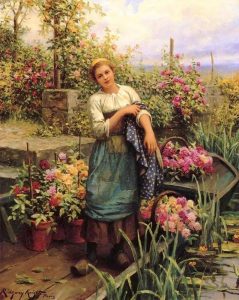
Ouida
TWO LITTLE WOODEN SHOES
Chapman and Hall, 193 Piccadilly, 1874
CHAPTER I.
Bebee sprang out of bed at daybreak. She was sixteen.
It seemed a very wonderful thing to be as much as that — sixteen — a woman quite.
A cock was crowing under her lattice — he said how old you are! — how old you are! every time that he sounded his clarion.
She opened the lattice and wished him goodday, with a laugh. It was so pleasant to be woken by him and to think that no one in all the world could ever call her a child any more.
There was a kid bleating in the shed. There was a thrush singing in the dusk of the sycamore leaves. There was a calf lowing to its mother away there beyond the fence. There were dreamy muffled bells ringing in the distance from many steeples and belfries where the city was; they all said one thing: “How good it is to be so old as that — how good, how very good!”
Bebee was very pretty.
No one in all Brabant ever denied that. To look at her it seemed as if she had so lived amongst the flowers that she had grown like them, and only looked a bigger blossom — that was all.
She wore two little wooden shoes and a little cotton cap, and a grey kirtle — linen in summer, serge in winter; but the little feet in the shoes were like rose-leaves, and the cap was as white as a lily, and the grey kirtle was like the bark of the bough that the apple blossom parts when it peeps out to blush in the sun.